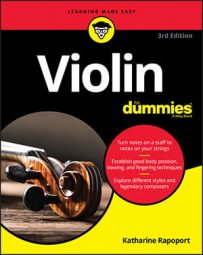Preparing the bow and fingers for slurs means coordinating certain techniques on the violin. This slurring exercise may remind you of a country dance, where the caller first walks you through all the steps slowly and separately, before the band strikes up and you whirl into action.
Slurring two notes in one bow stroke is easy if you work your way through this preliminary exercise below, on your A string. In this exercise, the first time you put two notes into one bow stroke, briefly stop the bow on the string between notes. Try these moves:
Use only half of your bow on the down-bow for the first A, and then stop your bow on the string.
Land finger 1 on the A string while the bow is stopped (and you can stop the bow for as long as you need — just move very calmly at first).
Continue your down-bow until you’ve bowed all the way to the tip.
Stop the bow briefly at the tip, and then begin an up-bow while finger 1 is still playing on the A string.
Stop the bow on the string when you arrive at the middle of the bow, and then lift finger 1 off the A string while the bow is stopped.
Continue the up-bow smoothly on the open A string until you reach the frog.
Use the same process, but with fingers 2, 3, and 4 in the subsequent measures.
Moving on to smooth slurs is just a step away. When the bow distribution is even and the fingers move independently of what the bow does, you’re all set for real legato.
 Slurring from an open string to a finger and then back again.
Slurring from an open string to a finger and then back again.
Play a few calm bow strokes on open A to establish the smooth sound. When the bow speed is even, try adding finger 1 during the course of the first “real” down-bow stroke of the exercise, landing finger 1 on the string as you pass the midpoint of the bow. On the following up-bow, lift finger 1 off again as you pass the midpoint of the up-bow stroke. The same steps work for all of the finger combinations above. Watch this smooth legati to see it in action.
Now that you have the basic idea about slurs, here’s an overview of the different slurs you meet in real music so that you can be as prepared as a Boy Scout when you encounter legato galore!
Slurring between fingers
The most usual situation in slurring involves transitioning from one finger to another. You can see how to play a very smooth legato between any pair of fingers. Use the rest measures to get the next pair of fingers ready.
This exercise works a lot like the open-string slurs, except you prepare your starting finger on the string before you begin to bow. You can use the same idea for the different finger combinations. In all these exercises, the starting finger of each set can remain calmly on the string. Follow these moves:
Begin with finger 1 on the A string at the start of the first down-bow. As you begin the bow stroke near the frog, plan on using the first half of your down-bow for finger 1.
Prepare finger 2 over its spot, then land the finger decisively as you continue your down-bow into the upper half of the bow, without changing the bow speed at all as finger 2 lands. Continue bowing on finger 2 until you reach, or almost reach, the tip of the bow.
Release finger 2 from the string at the end of the stroke, just as you change bow direction, and then start the up-bow on finger 1, and so on.
Feel free to repeat a measure a few times to pattern the moves and gain confidence.
These slurs use the first finger pattern for now, with finger 2 placed very close to finger 3, which is on its fingerboard guide. Later on, when you want to refine your skills or challenge yourself, try the same exercises with other finger patterns, so that you’re fluent at slurring in any key.

Adding two-note slurs to scales
After you get going with two-note slurs, apply your new bowing skills to some scales.
Start by using music that your left-hand fingers know well: your most basic scales. Follow these steps as illustrated below, and you’re slurring smoothly:
Try the simple one-octave A major scale, starting on open A and using détaché bowing, with a separate stroke for each note.
Play the same scale a second time, but this time, use preliminary stopped bows to prepare for slurring, with two notes per bow stroke.
Play the scale a third time through, and continue your bow strokes smoothly, without stopping during finger changes on the two-note
You have one empty measure, between the two scales, to set up your new finger pattern.
You can prepare slurs on any scale or song using the method outlined in these steps.


